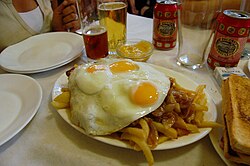 Chorrillana | |
| Alternative names | Bistec a la Chorrillana |
|---|---|
| Place of origin | Chile |
| Main ingredients | French fries, meat, onion, fried eggs, salt, cheese and other spices |
Chorrillana is a Chilean dish consisting of a plate of salted French fries topped with different types of sliced meat, sausages and other ingredients, most commonly scrambled or fried eggs, and caramelized onions. [1] [2] [3] It is commonly served as a comfort food in bars.
Because of its large size, it is usually served as a dish to share. There are several recipes for the chorrillana, depending on the restaurant and the chef. The base of beef and fries is the only constant. Traditional recipes mix scrambled egg, fried onion and sliced beef. [1] Some preparations may use chopped frankfurter sausages, chorizo, tomatoes and seasonings such as garlic or oregano. [4]
Chorrillana refers to a sauce inspired by Asian immigrants in Chorrillos, near Lima, Peru. [5] That was adapted to the ingredients of the area and it’s part of the traditional Peruvian cuisine, during the Pacific war Chileans had access to the dish specially during the San Juan and chorrillos battle and later adapted it to their cuisine claiming it as theirs as many other Peruvian dishes.[ citation needed ]
This dish is similar to the Québécois dish poutine and the Peruvian classic street food salchipapa.